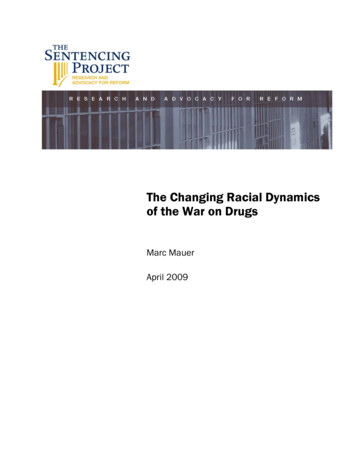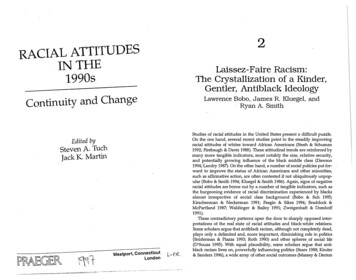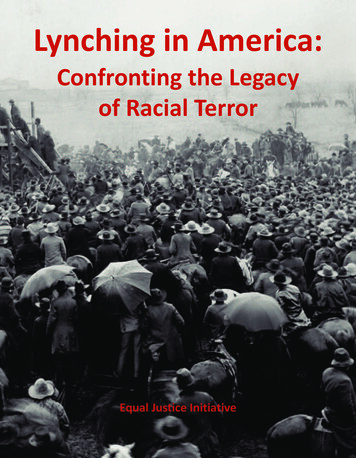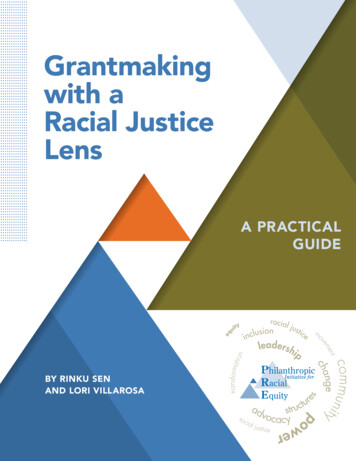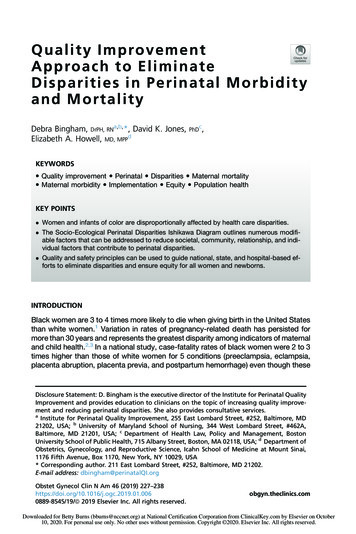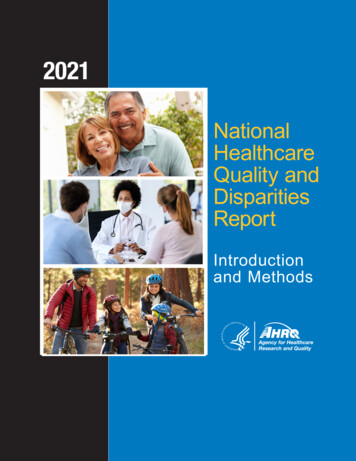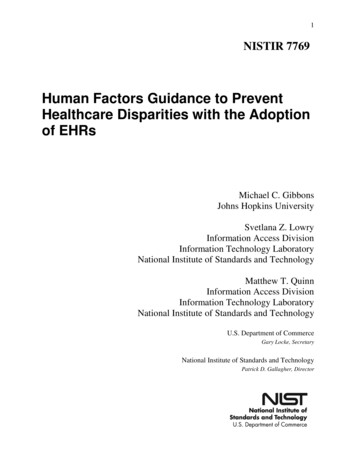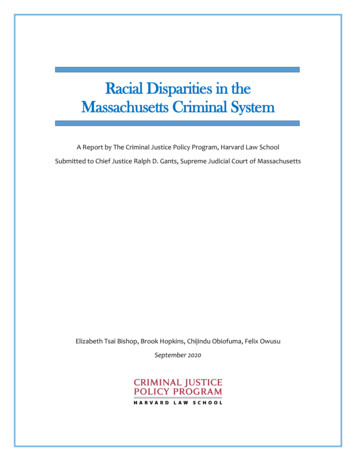
Transcription
Racial Disparities in theMassachusetts Criminal SystemA Report by The Criminal Justice Policy Program, Harvard Law SchoolSubmitted to Chief Justice Ralph D. Gants, Supreme Judicial Court of MassachusettsElizabeth Tsai Bishop, Brook Hopkins, Chijindu Obiofuma, Felix OwusuSeptember 2020
AcknowledgmentsWe thank the Massachusetts Trial Court, Massachusetts Department of Criminal JusticeInformation Services, Massachusetts Department of Corrections, and the Office of theCommissioner of Probation for sharing their data with us. We are grateful to Lee Kavanaghand Melaine Malcolm for answering our questions about the data. We thank ProfessorsCarol Steiker, Holger Spamann, and Crystal Yang for essential guidance and feedback. Wethank Benjamin Lu for his invaluable assistance in collecting, organizing, and cleaning thedata. We are grateful to Benjamin Grossman and Melanie Fontes for excellent researchassistance and to the entire staff of CJPP for their expertise and support. This reportbenefitted from the assistance and helpful comments of many attorneys, judges,researchers, agency staff, and others. We are especially grateful to Claudia Arno, BeverlyCannone, Bobby Constantino, Nasser Eledroos, Sophia Davis, Sana Fadel, Benjamin Forman,Aditi Goel, Rahsaan Hall, Sydney Hanlon, Lynsey Heffernan, Sonya Khan, Rhiana Kohl, AgapiKoulouris, Laura Lempicki, Tara Maguire, Jack McDevitt, Lia Monahon, Daniel J. Pires, JoshuaRaisler Cohn, Ryan Rall, Tom Ralph, Deborah Ramirez, Sadiq Reza, Erika Rickard, DehliaUmunna, Brian Welch, Douglas H. Wilkins, Eva Yutkins-Kennedy, and seminar participants atthe Program in Criminal Justice Policy and Management at Harvard University. We gratefullyacknowledge funding from the Dean of Harvard Law School, the Program in Criminal JusticePolicy and Management, and the Multidisciplinary Program in Inequality and Social Policy atHarvard University. Copyright 2020, Criminal Justice Policy Program at Harvard Law School. All rights reserved.For more information or permissions please contact Felix Owusu at owusu@g.harvard.edu.i
Table of ContentsExecutive Summary. 1Introduction .3Data Sources . 4Trial Court . 5DCJIS . 6Other Data . 6Data Requested and Not Received and Unusable Data . 7Data Limitations . 8Defendant Demographics & Case Characteristics .11Defendant Demographics. 13Charges Filed . 18Pretrial, Adjudication, & Disposition . 22Pretrial Phase. 22Adjudication & Disposition . 26Sentencing .28Racial Disparities in Sentencing . 30Regression Results . 33Decision Points – Incarceration Disparities . 38District Court vs. Superior Court Jurisdiction. 38Charge Type . 42Mandatory and Statutory Minimums in Superior Court .52Murder Cases . 60Charge Reductions . 61Conclusion . 64Appendices . 65ii
Executive SummaryPeople of color are drastically overrepresented in Massachusetts state prisons. According tothe Massachusetts Sentencing Commission’s analysis of 2014 data, the Commonwealthsignificantly outpaced national race and ethnicity disparity rates in incarceration,imprisoning Black people at a rate 7.9 times that of White people and Latinx people at 4.9times that of White people. 1This report explores the factors that lead to persistent racial disparities in the Massachusettscriminal system by leveraging detailed administrative data from several agencies, includingthe Massachusetts Trial Court, the Department of Criminal Justice Information Services, andthe Department of Correction. These data provide a useful, if incomplete, window intoseveral different stages of the criminal system from charging and bail to adjudication andsentencing.In this report, we focus particularly on understanding the factors that contribute to the largedisparities in incarceration rates that motivated this work. Through our analysis, we foundthat Black and Latinx people are overrepresented in the criminal caseload compared to theirpopulation in the state. White people make up roughly 74% of the Massachusetts populationwhile accounting for 58.7% of cases in our data. Meanwhile, Black people make up just 6.5%of the Massachusetts population and account for 17.1% of cases. Latinx people are similarlyoverrepresented, making up 8.7% of the Massachusetts population but 18.3% of the cases inthe sample.In addition to being overrepresented relative to their share of the state population, Blackand Latinx people are less likely than White people to have their cases resolved through lesssevere dispositions such as pretrial probation or continuances without finding (CWOFs).Among those sentenced to incarceration, Black and Latinx people sentenced toincarceration receive longer sentences than their White counterparts, with Black peoplereceiving sentences that are an average of 168 days longer and Latinx people receivingsentences that are an average of 148 days longer.We use regression analysis to consider several factors that may contribute to or explain thesubstantial disparities we document, including the defendants’ criminal history anddemographics, initial charge severity, court jurisdiction, and neighborhood characteristics.The regression analysis indicates that even after accounting for these characteristics, Blackand Latinx people are still sentenced to 31 and 25 days longer than their similarly situatedWhite counterparts, suggesting that racial disparities in sentence length cannot solely beexplained by the contextual factors that we consider and permeate the entire criminaljustice process.1MASSACHUSETTS SENTENCING COMMISSION, SELECTED RACE STATISTICS 2 (Sept. 27, /tu/selected-race-statistics.pdf.1
Our analysis shows that one factor—racial and ethnic differences in the type and severity ofinitial charge—accounts for over 70 percent of the disparities in sentence length.We explore several mechanisms by which racial disparities in initial charging decisions leadto the substantial average disparities we document. We find that: Black and Latinx people are more likely to have their cases resolved in Superior Courtwhere the available sentences are longer, both because they are more likely toreceive charges for which the Superior Court exercises exclusive jurisdiction andbecause prosecutors are more likely to exercise their discretion to bring their cases inSuperior Court instead of District Court when there is concurrent jurisdiction.Black and Latinx people charged with drug offenses and weapons offenses are morelikely to be incarcerated and receive longer incarceration sentences than Whitepeople charged with similar offenses. This difference persists after controlling forcharge severity and additional factors.Black and Latinx people charged with offenses carrying mandatory minimumsentences are substantially more likely to be incarcerated and receive longersentences than White people facing charges carrying mandatory minimumincarceration sentences.Our data do not allow us to determine conclusively the extent to which aggregatedifferences in initial type and charge severity across racial groups reflect police andprosecutor discretion versus differences in criminal conduct. We note, however, that amongthe subset of cases where the person was sentenced to incarceration in a state prison (i.e.cases involving charges that carry the longest potential sentences and where the racialdisparity is largest), Black and Latinx people are convicted of charges roughly equal inseriousness to their White counterparts despite facing more serious initial charges. Blackpeople in particular who are sentenced to incarceration in a state prison are convicted of lesssevere crimes on average than White people despite facing more serious initial charges andreceiving longer sentences.The fact that the level of seriousness of the final conviction offense is similar across race isan indication that the underlying conduct in these cases may be similar across race.However, we do not observe the underlying circumstances of the case in the administrativedata, so we cannot determine this conclusively. Still, the disparity in initial charge levelappears to play an important role in determining sentencing outcomes, and this is notsurprising given the role that initial charges play in the plea bargaining process from whichthe vast majority of convictions result. Our results highlight the central role that initialcharging decisions play in sentencing. It appears that the adjudication and plea bargainingprocesses attenuate disparities in charge severity, but initial differences continue toinfluence sentencing even if defendants of color are not convicted of the more seriousoffenses with which they are initially charged.It is also worth noting that the available administrative data presented significant obstaclesto our analysis, some of which we were able to overcome through time-consuming2
workarounds, and some of which limited the scope of our analysis. Certain obstacles weencountered have since been corrected through upgrades to data systems, but otherspersist. These include: Inadequate linking of records across agencies Unavailability of statewide police data in usable electronic format Unavailability of district attorney data Inadequate or inconsistent electronic tracking of key data includingo Identity of presiding judgeo Identity of prosecutoro Length of pretrial detentiono Outcomes of key pretrial motionso District Court/Boston Municipal Court cases that are subsequently indicted inSuperior Courto Use of diversion programsIn Appendix 2 we detail these data challenges and suggest policy reforms to improve thequality of the data so that it may be used for future research to increase our understandingof racial disparities in the Massachusetts criminal system.IntroductionThis report is the culmination of a research project undertaken by researchers at HarvardLaw School at the request of Massachusetts Supreme Judicial Court Chief Justice RalphGants. In his October 2016 State of the Judiciary address, Chief Justice Gants cited datagathered by the Massachusetts Sentencing Commission showing “great disparity in therates of imprisonment among Whites, African-Americans, and Hispanics in thisCommonwealth.” 2 He expressed the need to take “a hard look at how we can better fulfillour promise to provide equal justice for every litigant” 3 and announced a collaborative studywith Harvard Law School to examine racial and ethnic disparities in the Massachusettscriminal system. 4 Using data collected from the Massachusetts Trial Court, the Departmentof Criminal Justice Information Services, the Department of Correction, the MassachusettsProbation Service, and other agencies, this report analyzes racial and ethnic disparitiesthroughout the criminal process.According to the Sentencing Commission’s analysis of 2014 data, the Commonwealthsignificantly outpaced national race and ethnicity disparity rates in incarceration,2Chief Justice Ralph D. Gants, Massachusetts Supreme Judicial Court, Annual Address: State of the Judiciary 5(Oct. 20, 2016), 6 0.pdf.3Id.4Id. at 5-6.3
imprisoning Black people at a rate 7.9 times that of White people and Latinx 5 people at 4.9times that of White people. 6 By comparison, according to the Sentencing Commission’sanalysis, the national average rate of imprisonment for Black people was 5.8 times that ofWhite people, and for Latinx people, it was 1.3 times that of White people. 7 A 2016 reportfrom The Sentencing Project comparing racial and ethnic disparities in incarceration ratesacross all 50 states ranked Massachusetts the highest in disparities for Latinx people and the13th highest for Black people. 8This study examines the Massachusetts criminal process from charging to sentencing. Itidentifies points in the process where racial disparities exist, with a focus on the decisionsthat appear to contribute to the racial disparities in incarceration rates in theCommonwealth. The data analyzed below do not allow us to conclusively isolate the impactof unconscious bias, prejudice, and racism in generating the disparities we document. Wesupplement our data analysis with additional research from across the country whererelevant and a review of the history of racial disparities in criminal justice more broadly (seeAppendix 1) to provide context and insight into possible explanations for the disparities wedocument.Data SourcesThe majority of our analysis relies on data from two sources: the Massachusetts Trial Courtand the Massachusetts Department of Criminal Justice Information Services (DCJIS). We alsoanalyze data from other sources such as the Department of Corrections (DOC). There areseveral types of data that we requested but did not receive, and data that we received butwere unable to analyze for various reasons. The data that we did receive containedsubstantial problems in quality and consistency that hampered our analysis in certain ways.We were given unprecedented access to Massachusetts criminal data and our experiencecollecting, cleaning, and analyzing this data makes clear that, at the time of our study, datacollection practices in Massachusetts presented a significant barrier to understanding racialdisparities at all stages of the criminal justice system.5Latinx is a gender inclusive term that refers to people of Latin descent, replacing the more limited designationof Hispanic, which generally refers to Spanish or Spanish-speaking people. See GENIAL, IS IT HISPANIC,CHICANO/CHICANA, LATINO/LATINA, OR LATINX? /files/Genial 2017 Terms of Usage.pdf; see also Cristobal SalinasJr. & Adele Lozano, Mapping and Recontextualizing the Evolution of the Term Latinx: An Environmental Scanningin Higher Education, Journal of Latinos and Education, 18 J. LATINOS AND EDUC. 302, 303 (2019) (“The term Latinorefers to people from the Caribbean, as well as Mexico, and the countries that comprise Central and SouthAmerica, even those countries that are not Spanish-speaking (Belize, Brazil, French Guiana, Guyana, andSuriname).”).6MASSACHUSETTS SENTENCING COMMISSION, SELECTED RACE STATISTICS 2 (Sept. 27, /tu/selected-race-statistics.pdf.7Id.8ASHLEY NELLIS, THE SENTENCING PROJECT, THE COLOR OF JUSTICE: RACIAL AND ETHNIC DISPARITY IN STATE PRISONS 17(2016), prisons/.4
Trial CourtThe Trial Court provided us with records from their case management system, MassCourts,for every Boston Municipal Court (“BMC”) and District Court criminal case with at least onecharge filed and disposed between the start of 2014 and the end of 2016. The Trial Court alsoprovided us with all Superior Court cases that had at least one charge disposition betweenthe start of 2014 and the end of 2016 regardless of when the case was filed. Because casescan take much longer in Superior Court, many of the cases in our Superior Court data setwere filed before 2014, indeed one case was filed as early as 1970. Some people appear inour data set more than once if they had multiple cases filed against them and/or disposedwithin our time period. Some of the cases in our data set involve both civil and criminalcharges, but we excluded all data about civil charges from our analysis.Table 1: Trial Court DataUnitIndividualsCasesCriminal ChargesAfter Filtering Count333,051553,8011,164,041For each case, we received information about the initial charges, the dispositions,sentencing information, and a record of court events associated with each case. We alsoreceived information about the defendants, including race, ethnicity, age, and homeaddress. The race information we received is recorded by court personnel and is obtainedthrough self-reporting, observation, and/or documents such as the complaint. For moreinformation on how race is recorded in the data we received from the Trial Court, seeAppendix 5.The records we received from the Trial Court came from the MassCourts database.MassCourts is an electronic case management system, not the official docketing system.Accordingly, while the official paper docket file of each case is complete, the informationrecorded in MassCourts varied depending on the practices of the individual clerks across theCommonwealth. The system has been expanded in recent years and we are told that acomparable data set pulled today would include the full docket. However, in the data thatwas available at the time of our request, there are some fields that rarely contain data, andwe do not know whether the data is missing because there were no relevant events in thecase or because the clerk simply did not record that event in the database. The only way toanswer that question would be to look at the official docket, which is a paper file. Oneexample of an electronic field that was rarely completed in our data was the charge5
amendment field. 9 As a result, we were unable to determine the final charges of convictionfor most of the cases in our data set, particularly cases involving less severe charges andthose that did not result in prison sentences. We describe more fully this and otherchallenges we encountered with the MassCourts data in the Data Limitations section belowand in Appendix 2.DCJISThe Department of Criminal Justice Information Services (DCJIS) is a department within theexecutive branch of the Commonwealth of Massachusetts under the Executive Office ofPublic Safety and Security that oversees Criminal Offender Record Information (CORI)records and criminal history data. 10 DCJIS provided us with Court Activity RecordInformation (CARI) records for all individuals who have at least one case in the data wereceived from the Trial Court and an assigned Probation Central File (PCF) number in theTrial Court data. 11 These CARI records contain information about all offenses that a personhad been charged with as of 2017 when the data was pulled. This includes charges outsidethe time period of our data set. For every charge, we received information about the natureof the offense, how it was disposed, and whether and what type of sentence was imposed.Other DataWe received data from the Massachusetts Department of Corrections (DOC) for individualsin our Trial Court data set who were sentenced to serve time in a DOC institution. Of the4,255 relevant cases from the Trial Court data, we received DOC data for 4,154 of them. 12Data from the DOC includes information about the individual’s race, ethnicity, finalconviction offenses, sentence term, and earliest possible release date.We supplement our administrative data on the Massachusetts criminal system with datafrom the American Community Survey. The American Community Survey is conducted everyyear and collects information about education, housing, jobs, and other social and economicmeasures. 13 We used data from the 2015 five-year data profile, which provides data collectedbetween 2011 and 2015. We used each defendant’s home address to access information atthe zip code level about their neighborhoods including gender ratios, racial ratios, povertyrates, high school and college graduation rates, rates of single parent households,9Court personnel informed us that most clerks in BMC and District Courts did not have access to a chargeamendment field at the time our data was recorded. That feature was added in 2018 so more recent court datawould contain this information.10The definition of CORI has expanded over time. Its precise definition and regulations regarding its use andaccessibility can be found at 803 CMR 2.00.11A small number of defendants in the Trial Court data (7.2%) do not have a PCF number. This made itimpossible for us to request criminal history information from DCJIS for those people.12There were 101 people who, according to the Trial Court data, received a prison sentence, but for whom theDOC had no data. We were unable to detect a pattern in those cases or account for the missing /about/acs-and-census.html.6
unemployment rates, and median income estimates. We use state-wide estimates forindividuals for whom no valid zip code was available.We also consulted legal and administrative sources such as the Massachusetts Code andpublications from the Massachusetts Sentencing Commission. Those sources are cited infootnotes throughout the report.Data Requested and Not Received and Unusable DataWe requested arrest data from every local police department we could identify inMassachusetts. Although a few departments provided us with data in a usable form, manydid not respond or provided data in a format that could not be readily aggregated andanalyzed, such as pdfs or printed arrest reports. For this reason, we were unable to providean analysis of arrest data in this report.We also requested prosecutor data through the Massachusetts District AttorneyAssociation, but we did not receive data from them. One District Attorney provided us withdata but we were unable to use it because there was too much missing data. AnotherDistrict Attorney offered to provide data, but due to the limitations of their data system, itwould have taken too long for them to provide us with aggregated data.We requested data from the Office of the Commissioner of Probation (OCP). The OCPworked with the Trial Court to identify probation data that corresponded with the casescontained in our data set. Although our Trial Court and DCJIS data indicated that more than91,000 individuals in our data set received a probation sentence, the OCP was only able toidentify around 42,000 records that were linked to a Trial Court case in our data set. Courtpersonnel explained that Trial Court data is organized by case, but OCP data is organized bydefendant. A person’s OCP file contains data related to each of their probation terms but itis not separated by case. The only way to filter that data by case is if it is linked to the TrialCourt record. When a case comes to the OCP after sentencing, it is best practice for OCPpersonnel to create a copy of the Trial Court record. This copy serves to link any probationdata associated with that case to the Trial Court record. When that link is not created, thereis no way to sort probation data by case. Because the link was apparently missing in over 75%of cases, we were unable to use OCP data to measure imposition of probation sentencesand probation sentence length. Instead, we had to use Trial Court and DCJIS sentencingdata.Although we received (and used) data from the Trial Court, there was a small amount ofdata that we requested and did not receive. We requested information about judges fromthe Trial Court, but we were told that data on judges is not always entered electronically,and when it is, the session judge, not the presiding judge is recorded. For this reason, theTrial Court did not provide that data. Similarly, the Trial Court did not provide us data aboutshow cause hearings because such data was not collected and aggregated electronically.7
We were given data about fee and fine payment but it was linked by case not by charge anddid not include imposition data so we were unable to use the data to analyze finesentencing. In addition, court personnel advised us that the bail docket data could not beused to calculate the length of pretrial detention because the electronic record was notsufficient to determine pretrial release.Data LimitationsIt is important to emphasize that our data measures only contact with the criminal systemand not crimes actually committed. Law enforcement resources are deployed in certainareas and populations more than others, and this can influence whether unlawful conductresults in contact with the formal criminal justice system. This report analyzes only whathappens to cases once they are initiated. It does not address or explain disparities in thepipeline that leads to contact with the criminal system.Having been granted unprecedented access to agency data, we nevertheless encounteredobstacles in tracking cases through the criminal process. For example, it is challenging totrack cases that move from BMC/District Court to Superior Court. If a case starts in a BMC orDistrict Court and is later indicted in Superior Court, which is common, it could appear in ourdata twice. Both cases pertain to the same underlying conduct, but they would have distinctcase identifiers and they would not be linked in any way in the MassCourts system.Additionally, certain dispositions, including when District Court/BMC cases are dismissedafter indictment by a grand jury in Superior Court, are not recorded consistently inMassCourts and may not be apparent to clerks depending on the procedural practices of thedistrict attorney. Because there is no link between cases that are dismissed in District Courtand subsequently indicted in Superior Court, it is difficult to accurately measure these caseoutcomes. This means that our estimates of conviction rates include some measurementerror, as some cases that are listed as dismissed from District Courts are marked as suchbecause the defendant was eventually indicted and not because the charges were actuallydismissed, although we did take steps to minimize this error (See Appendix 11).In addition to difficulty with tracking cases, we encountered some problems with missingrace and ethnicity data. Our measure of ‘race’ combines information from various datasources that was provided under the label not only of ‘race’ but also ‘ethnicity.’ This isbecause individual data sources had large gaps in race and ethnicity data and appeared touse race and ethnicity interchangeably in practice. Specifically, the Trial Court uses separatecategories to denote race and ethnicity. The racial categories from the Trial Court include“American Indian/Alaska,” “Asian,” “Black/African American,” “Native Hawaiian/Pacific,”“Other Race/Multi-Race,” “White,” and “Not known/Not reported.” The ethnicities are“Hispanic or Latino,” “Non Hispanic or Latino,” and “Unknown/Not reported.” TheDepartment of Criminal Justice Information Services uses a single category to describe raceand ethnicity jointly. The categories included in the DCJS data are “Asian,” “Black, non8
Hispanic,” “Cape Verdean,” “Hispanic,” “Native American,” “Unknown,” and “White, nonHispanic.” Appendix 5 provides a full account of how we processed and combined data onrace and ethnicity to generate the measure we use throughout the rest of this report. Aftercombining data from both sources, we were still missing information on race and/orethnicity in approximately 5% of cases.Our data was also missing information on final conviction offenses for most cases. The datafrom the Trial Court does not contain a field for final conviction offense and does notconsistently indicate when charges are reduced and amended, which is common in thecourse of plea negotiations. According to court personnel, the field for describing amendedcharges is not consistently used and thus the data undercounts the extent to which initialcharges are amended. Likewise, lesser-included charges were not recorded in an el
Executive Summary . People of color are drastically overrepresented in Massachusetts state prisons. According to the Massachusetts Sentencing Commission's analysis of 2014 data, the Commonwealth significantly outpaced national race and ethnicity disparity rates in incarceration,


